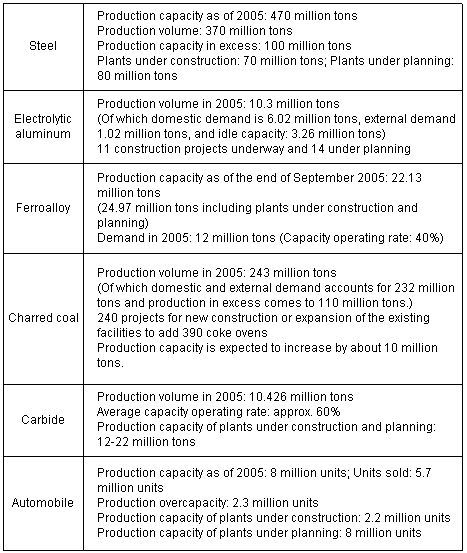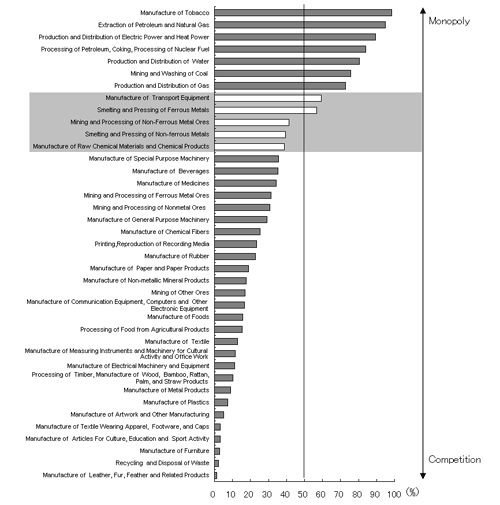Excess capacity in many industries in China has become more and more apparent. As Professor Zhou Qiren of Peking University's China Center for Economic Research pointed out, this is attributable not only to cyclical factors but also, at least in part, structural changes that private enterprises have started to play a major role in the economy in place of state-owned enterprises during the transition process from a planned economy to a market economy (note). Indeed, this phenomenon of excess production capacity is highly concentrated, not in industries monopolized by state-owned enterprises or those dominated by private enterprises, but in industries characterized by the mixed presence of both types of enterprise, such as steel and electrolytic aluminum (table 1 and chart 1).
In industries either monopolized or oligopolized by state-owned enterprises, supply shortage - rather than excess production capacity - is the norm. In the era of the planned economy, prices were artificially kept low under government control and thus demand exceeded supply for almost all goods. In this environment, there was no choice but to rely on non-market means such as rationing and queuing for the allocation of resources including consumer goods. Today, the market economy has taken shape in China. Yet, in some industries where high barriers to entry and monopoly remain intact, excess production capacity is not occurring because state-owned enterprises continue to try to maintain high prices by restraining production, and because the incentive to expand market share through investment is absent.
Meanwhile, in sectors where competition exists, excessive production capacity may occur temporarily as a result of excessive investments based on overly optimistic demand forecasts. But this situation will be short-lived; when supply exceeds demand product prices begin to fall whereby inefficient companies will be forced into bankruptcy and exit the market.
In contrast, overcapacity is typically found in industries where the monopoly power of state-owned enterprises is beginning to fade and private enterprises are aggressively trying to enter the market. As private enterprises seek to expand their market shares in pursuit of higher profits by investing in new facilities, market competition intensifies and inefficient state-owned enterprises suffer drastic falls in revenues, whereby their old facilities become excessive. Further fueling excessive production capacity is state-owned enterprises' attempt to maintain shares by expanding facility investments with such government support as loans from state-owned banks.
A typical example of this is the steel industry. With the rise of private enterprises, state-owned enterprises' share in the steel market has declined to about 50%. As competition intensifies, an excess in production capacity has become evident. According to Ma Kai, chairman of the National Development and Reform Commission (NDRC), China's steel production capacity already exceeds demand (370 million tons in 2005) by 100 million tons, while steel plants under construction and currently planned for construction will bring 70 million and 80 million tons respectively of additional capacity.
The types of industry with excessive production capacities have been changing with time, reflecting differences among industries in the timing of entry of private enterprises. For instance, in the 1980s, shortly after the launch of the reform and opening-door policy, there was a period when the home appliance industry saw fierce price competition and its investment expansion outpaced increase in demand, resulting in excess production capacity. Subsequently, however, inefficient enterprises were forced out of the market and only those capable of supplying high-quality products even at low prices survived.
Production overcapacity not only signals a waste of resources but also imposes deflationary pressure on the economy. To solve this problem, the government has implemented control measures such as stricter restrictions over new investments in certain industries. However, to facilitate the transition from a planned economy to a market economy, the government should urge inefficient state-owned enterprises to exit by promoting privatization, instead of erecting barriers that inhibit the entry of private enterprises. As part of this endeavor, the government should encourage private enterprises to make good use of the existing facilities of state-owned enterprises, for instance, through mergers and acquisitions, rather than making new investments.




